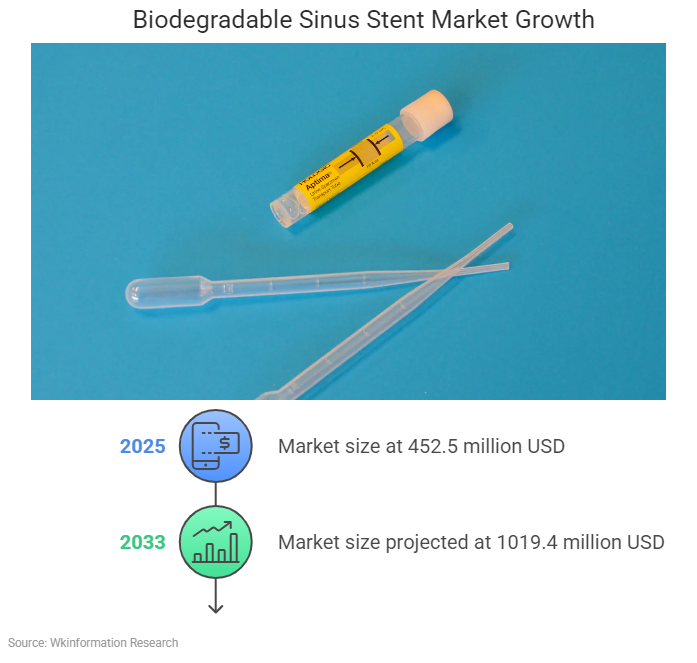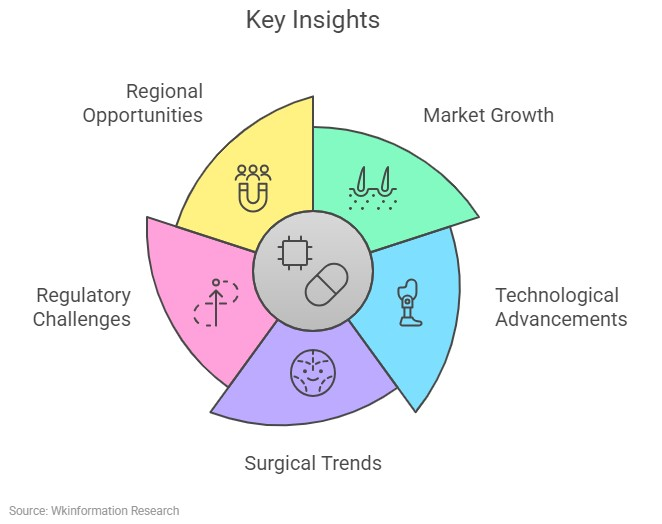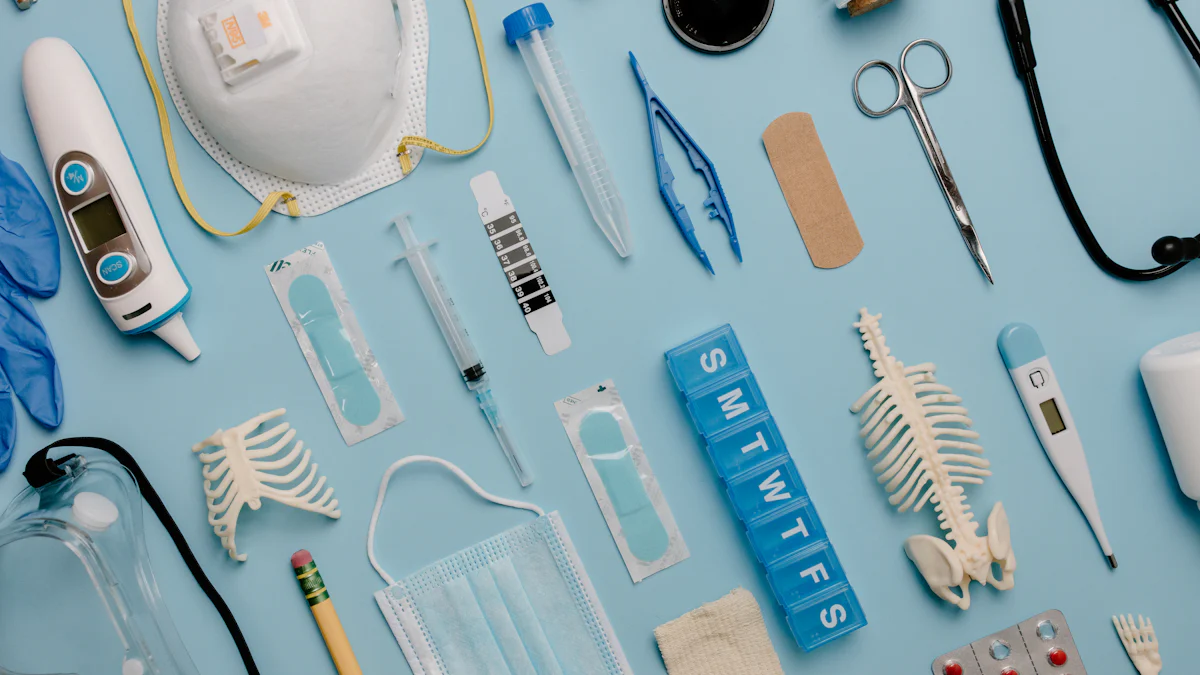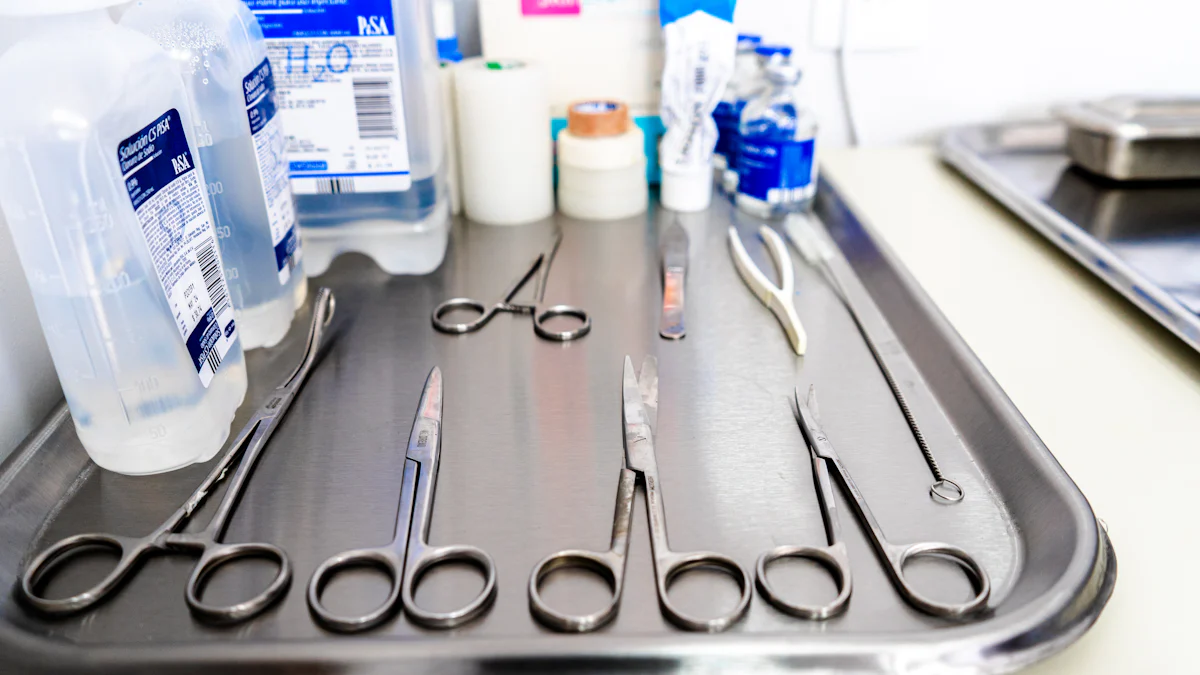
The biodegradable sinus stent market is poised for remarkable growth, driven by advancements in technology and evolving healthcare demands. Projections indicate the market will expand from 452.5 million USD in 2025 to 1019.4 million USD by 2033, with a compound annual growth rate (CAGR) of 10.69%. This growth reflects increasing demand for effective treatment options for sinusitis and related conditions. Recent trends highlight the emergence of innovative product offerings, such as drug-eluting biodegradable stents, which improve patient outcomes through sustained drug delivery. These innovations, coupled with the adoption of computer-aided design for enhanced precision, underscore the market’s potential to revolutionize sinus care.
Key Insights
- The biodegradable sinus stent market may grow from 452.5 million USD in 2025 to 1019.4 million USD by 2033. This is because more people need better sinusitis treatments.
- New stents that release medicine over time help patients heal better. These stents are becoming a popular choice for sinus care.
- Less invasive surgeries are now more common. They help patients recover faster and lower the chance of infections. This increases the need for biodegradable stents.
- Rules and high production costs make it hard for the market to grow. Companies and regulators need to work together to fix these issues.
- Countries in Asia-Pacific and Latin America could see big growth. This is due to more spending on healthcare and better knowledge about sinus health.

Market Overview
Key Drivers of the Biodegradable Sinus Stent Market
Several factors fuel the growth of the biodegradable sinus stent market. The increasing prevalence of chronic sinusitis has created a pressing need for effective treatment options. Bioabsorbable stents address this demand by providing a minimally invasive solution that supports sinus healing while eliminating the need for removal procedures. Additionally, advancements in bioabsorbable technologies have enhanced the functionality and safety of these stents, making them a preferred choice among healthcare providers. The growing preference for minimally invasive surgical techniques further accelerates market growth, as patients and physicians alike seek procedures that minimize recovery time and reduce risks.
Challenges Impacting Market Growth
Despite its promising outlook, the biodegradable sinus stent market faces notable challenges. Regulatory hurdles remain a significant barrier, as stringent approval processes delay the introduction of new products. These requirements often increase development costs, which, in turn, elevate the price of bioabsorbable stents. High costs can deter adoption, particularly in regions with limited healthcare budgets. Moreover, the complexity of manufacturing bioabsorbable stents adds to production expenses, further impacting market expansion. Addressing these challenges will require collaboration among manufacturers, regulators, and healthcare providers to streamline approval processes and reduce costs.
Key Trends in the Biodegradable Sinus Stent Market

Advancements in Biodegradable Materials
The biodegradable sinus stent market has witnessed significant progress in material science, leading to the development of bioabsorbable stents with enhanced performance. Manufacturers now utilize advanced materials that improve biocompatibility, flexibility, and safety. The table below highlights some of the key materials driving innovation in this space:
| Material Type | Description | Growth Potential |
|---|---|---|
| Polylactic Acid (PLA) | Biocompatible, biodegradable thermoplastic from renewable resources. | Significant share in market |
| Polyglycolic Acid (PGA) | Known for high strength and elasticity, suitable for flexible applications. | Steady growth expected |
| Polycaprolactone (PCL) | Biodegradable polyester with excellent biocompatibility and flexibility. | Moderate growth anticipated |
| Polyethylene Glycol (PEG) | Enhances biocompatibility and reduces infection risk. | Steady growth driven by demand |
| Polyurethane | Versatile polymer with customizable properties for specific requirements. | Significant growth expected |
These materials enable the production of bioabsorbable stents that dissolve naturally after fulfilling their purpose, eliminating the need for removal procedures. This advancement not only reduces patient discomfort but also aligns with the growing focus on sustainability in healthcare.
Increasing Adoption of Minimally Invasive Procedures
Minimally invasive procedures have become a cornerstone of modern sinus treatments, driving the adoption of bioabsorbable stents. Several factors contribute to this trend:
- The increasing prevalence of chronic sinusitis has created a demand for effective yet less invasive solutions.
- Technological advancements in sinus dilation techniques have improved patient outcomes and reduced recovery times.
- Both patients and healthcare providers prefer minimally invasive options due to reduced pain and complications compared to traditional surgeries.
These procedures offer numerous benefits, including smaller incisions, faster recovery, and lower infection risks. Patients experience less trauma and quicker healing, while surgeons benefit from enhanced precision and control during operations. This shift towards minimally invasive techniques has significantly boosted the demand for bioabsorbable stents in the market.
Regulatory Developments and Approvals
Regulatory frameworks play a pivotal role in shaping the biodegradable sinus stent market. Recent years have seen an increase in approvals for bioabsorbable stents, reflecting advancements in product safety and efficacy. Regulatory bodies, such as the FDA and EMA, have streamlined approval processes for innovative stent designs, encouraging manufacturers to invest in research and development. However, stringent requirements still pose challenges, particularly for emerging players. Collaboration between regulators and manufacturers remains essential to ensure timely product launches without compromising safety standards. These developments highlight the importance of regulatory compliance in driving market growth and fostering innovation.
Focus on Sustainability and Patient-Centric Care
Sustainability has become a critical focus in the healthcare industry. The biodegradable sinus stent market reflects this shift by prioritizing eco-friendly solutions. Bioabsorbable stents dissolve naturally within the body, reducing medical waste and eliminating the need for additional removal procedures. This innovation aligns with global efforts to minimize environmental impact while enhancing healthcare efficiency.
Manufacturers have adopted sustainable practices in material selection and production processes. Advanced bioabsorbable materials, such as polylactic acid and polycaprolactone, are derived from renewable resources. These materials not only ensure biocompatibility but also support the industry’s commitment to reducing its carbon footprint. By integrating sustainability into product design, companies address environmental concerns while meeting the growing demand for innovative medical devices.
Patient-centric care remains another key priority in the market. Bioabsorbable stents improve the patient experience by offering minimally invasive treatment options. These stents dissolve after completing their function, eliminating the discomfort and risks associated with traditional stent removal. This feature enhances recovery and reduces the need for follow-up procedures, allowing patients to return to their daily lives more quickly.
“The integration of sustainability and patient-centric care in the biodegradable sinus stent market demonstrates the industry’s commitment to innovation and responsibility.”
Healthcare providers increasingly recognize the value of bioabsorbable stents in delivering effective and sustainable care. By focusing on both environmental and patient needs, the market continues to evolve, setting new standards for medical device innovation.
Market Share Analysis
Major Players and Their Market Shares
The biodegradable sinus stent market is dominated by several key players who hold significant shares due to their extensive product portfolios and global presence. These companies include:
- Boston Scientific
- Medtronic
- Stryker
- Olympus Corporation
- Zimmer Biomet
- Integra LifeSciences
- Acclarent
- Globus Medical
These organizations leverage their established reputations and advanced technologies to maintain leadership positions. Boston Scientific and Medtronic, for instance, have consistently introduced innovative stents that cater to the growing demand for minimally invasive sinus treatments. Their focus on research and development ensures they remain at the forefront of the market.
Competitive Strategies in the Market
Major players employ diverse strategies to strengthen their positions in the biodegradable sinus stent market. Research and development efforts remain a cornerstone, with companies investing heavily in creating bioresorbable stents that improve patient outcomes. Strategic partnerships and acquisitions also play a critical role. For example, collaborations between manufacturers and healthcare providers help expand market reach and enhance product accessibility.
Pricing strategies further differentiate competitors. While established players focus on premium-quality stents, emerging companies often adopt competitive pricing to attract cost-sensitive buyers. Sustainability initiatives, such as using eco-friendly materials, also contribute to competitive advantages. These strategies collectively enable companies to address the evolving needs of the sinus treatment market.
Role of Emerging Players and Startups
Emerging players and startups are reshaping the biodegradable sinus stent market by introducing innovative solutions. Many utilize advanced technologies, such as 3D printing, to develop unique stent designs. Strategic partnerships with larger firms allow these startups to access resources and expand their market presence.
Differentiation remains a key focus for these companies. By emphasizing affordability, quality, and sustainability, they cater to diverse consumer demands. Startups also target rapidly growing regions like Asia-Pacific, where the demand for sinus treatments continues to rise. Their ability to adapt quickly to market trends positions them as significant contributors to the industry’s growth.
Technological Innovations Driving the Market

New Biodegradable Material Technologies
The biodegradable sinus stent market continues to evolve with advancements in material science. Researchers are developing bioabsorbable materials that enhance the performance and safety of stents. These materials dissolve naturally within the body, eliminating the need for removal procedures. Polylactic acid and polycaprolactone are among the most widely used materials due to their biocompatibility and flexibility. These innovations allow manufacturers to create stents that adapt to the unique anatomical structures of patients, improving surgical outcomes. The integration of these materials into bioabsorbable stents aligns with the growing demand for sustainable and patient-centric solutions in the healthcare industry.
Integration of AI and 3D Printing in Stent Design
Artificial intelligence and 3D printing are transforming the bioabsorbable steroid-eluting sinus stent market. AI enhances product development by analyzing patient data to create personalized treatment plans. This technology improves surgical outcomes and reduces recovery times. Automation in manufacturing processes increases precision, reduces costs, and shortens production timelines.
3D printing plays a pivotal role in the rapid prototyping of stents. Designers can create intricate patterns using tessellation, enabling the production of various stent designs quickly. The process often involves converting 3D-printed models into silicone stents through injection molding. These advancements allow manufacturers to meet the growing demand for bioabsorbable stents while maintaining high-quality standards.
R&D Efforts and Clinical Trials in the Bioabsorbable Steroid-Eluting Sinus Stent Market
Research and development efforts drive innovation in the bioabsorbable steroid-eluting sinus stent market. Recent clinical trials have provided valuable insights into the efficacy of these stents. A subgroup analysis revealed improved outcomes for frontal sinus surgery patients over 90 days, regardless of asthma status or prior surgeries. High-level evidence suggests that these stents are particularly effective in the frontal sinus, where conventional treatments often fail to penetrate.
While these findings highlight the potential of bioabsorbable stents, further research is necessary to address cost concerns and long-term impacts on patient quality of life. Manufacturers continue to invest in R&D to refine stent designs and expand their applications in the market.
Regional Insights
North America: Market Leadership and Key Trends
North America leads the biodegradable sinus stent market due to several critical factors. The region experiences a high prevalence of sinusitis, which drives demand for effective treatment options. A robust healthcare infrastructure supports the adoption of advanced medical practices, enabling healthcare providers to integrate innovative solutions like biodegradable stents into their treatment protocols. Additionally, North America has a strong tendency to adopt cutting-edge medical technologies early, further solidifying its leadership position. These factors collectively contribute to the region’s dominance in the global market.
The United States plays a pivotal role in this leadership, with significant investments in research and development. The presence of major industry players also enhances the region’s competitive edge. Canada complements this growth with its focus on healthcare innovation and patient-centric care. Together, these countries set the benchmark for the global biodegradable sinus stent market.
Europe: Regulatory Landscape and Growth Opportunities
Europe represents a growing market for biodegradable sinus stents, driven by several favorable conditions. Increasing healthcare awareness among the population has led to a higher demand for advanced sinus treatments. The region’s well-established medical infrastructure supports the widespread adoption of these stents. Furthermore, Europe’s aging population, which is more susceptible to sinus issues, contributes to the rising demand for innovative solutions.
Key countries such as Germany, France, and the United Kingdom lead the market in Europe. These nations benefit from strong healthcare systems and substantial investments in medical research. Biodegradable sinus stents are increasingly utilized to manage recurrent sinus infections, which are challenging to treat with traditional methods. By providing sustained relief and support, these stents play a crucial role in addressing chronic sinusitis, further driving market growth in the region.
Asia-Pacific: Emerging Markets and Growth Potential
The Asia-Pacific region offers significant growth potential for the biodegradable sinus stent market. Several emerging trends highlight the region’s rapid development:
- Increasing healthcare expenditure across countries.
- Growing awareness about sinus health among the population.
- Expanding access to advanced medical treatments.
- A large patient pool that supports market growth.
- Favorable government initiatives aimed at improving healthcare infrastructure.
Countries like China, India, and Japan are at the forefront of this growth. Rising disposable incomes and improved healthcare access in these nations have accelerated the adoption of biodegradable sinus stents. The region’s focus on enhancing healthcare outcomes positions it as a key player in the global market.
Asia-Pacific’s dynamic growth underscores its importance as a hub for innovation and investment in the biodegradable sinus stent market.
Rest of the World: Challenges and Opportunities
The biodegradable sinus stent market in regions outside North America, Europe, and Asia-Pacific presents a mix of challenges and opportunities. Emerging economies in Latin America, the Middle East, and Africa are witnessing a gradual adoption of advanced medical technologies. These regions are enhancing their healthcare infrastructure, which includes the integration of biodegradable sinus stents. Increased healthcare spending and heightened awareness of chronic sinusitis drive this growth. Government initiatives aimed at improving healthcare access further support the market’s expansion.
Countries in these regions offer significant potential for market penetration. Rising disposable incomes and a growing middle class contribute to the demand for innovative medical devices. Healthcare providers in these areas are increasingly recognizing the benefits of biodegradable stents, such as reduced complications and improved patient outcomes. This recognition creates opportunities for manufacturers to establish a foothold in untapped markets.
Despite these opportunities, the market faces notable challenges. Regulatory environments in many of these regions remain stringent. Approval processes for new stents often require extensive testing and clinical trials. These requirements increase development costs and delay product launches. Manufacturers must navigate these complexities to bring their products to market successfully. Limited access to advanced manufacturing facilities in some regions also poses a barrier to local production.
“Emerging markets hold immense potential for the biodegradable sinus stent industry, but overcoming regulatory and logistical hurdles is essential for sustained growth.”
Collaboration between governments, healthcare providers, and manufacturers can address these challenges. By streamlining approval processes and investing in local production capabilities, stakeholders can unlock the full potential of these regions. The rest of the world represents a promising frontier for the biodegradable sinus stent market, provided these obstacles are effectively managed.
Future Outlook for the Biodegradable Sinus Stent Market
Market Forecast for 2025-2033
The biodegradable sinus stent market is expected to witness steady growth from 2025 to 2033. Analysts predict a consistent rise in market size, driven by the increasing demand for effective treatment options for sinusitis. The bioabsorbable steroid-eluting sinus stent market will likely benefit from advancements in material science and design, which enhance the safety and efficacy of stents. Innovations such as drug-eluting stents and AI-assisted designs will further expand the market’s potential. The forecast indicates that the market will continue to grow at a compound annual growth rate (CAGR) of 10.69%, with emerging markets playing a pivotal role in this expansion.
Growth Opportunities in Emerging Markets
Emerging markets, particularly in Asia-Pacific, Latin America, and the Middle East & Africa, present significant opportunities for the biodegradable sinus stent market. These regions are experiencing rapid advancements in healthcare infrastructure and increased healthcare expenditure. Rising awareness about chronic sinusitis and government initiatives to improve healthcare access are driving the demand for bioabsorbable stents. Additionally, ongoing research and development efforts focused on improving stent materials and designs are expected to boost adoption rates. Countries like China, India, and Brazil are at the forefront of this growth, offering manufacturers a chance to tap into a large and underserved patient population.
Challenges and Risks in the Market
Despite its promising outlook, the bioabsorbable steroid-eluting sinus stent market faces several challenges and risks. Potential allergic reactions to biodegradable materials and stent migration remain significant concerns. Device failure can also impact patient outcomes, reducing trust in these products. Strict market supervision and high research and development costs pose additional barriers for manufacturers. The expiration of drug patents and declining revenue from older products may further complicate market dynamics. Addressing these risks will require manufacturers to invest in robust quality control measures and innovative solutions to maintain market growth.
“While the biodegradable sinus stent market holds immense potential, overcoming these challenges will be critical to sustaining long-term growth.”
Potential for Innovation and Collaboration
The biodegradable sinus stent market offers immense potential for innovation and collaboration, driven by advancements in technology and the growing demand for patient-centric solutions. Manufacturers, healthcare providers, and research institutions are increasingly working together to address unmet needs and improve treatment outcomes.
Opportunities for Technological Advancements
The bioabsorbable steroid-eluting sinus stent market is ripe for technological breakthroughs. Researchers are exploring the integration of nanotechnology to enhance drug delivery mechanisms. This approach could enable stents to release medication more precisely, reducing side effects and improving efficacy. Additionally, the use of smart materials that respond to environmental changes within the sinus cavity represents a promising area of development. These innovations could revolutionize the way sinusitis is treated, offering patients more effective and personalized care.
Collaborative Efforts in Research and Development
Collaboration between industry leaders and academic institutions plays a pivotal role in driving progress. Joint research initiatives have already led to the development of advanced bioabsorbable materials that improve stent performance. Clinical trials conducted in partnership with healthcare providers ensure that new products meet safety and efficacy standards. These collaborations not only accelerate innovation but also help manufacturers navigate regulatory challenges more efficiently.
Expanding Access Through Partnerships
Strategic partnerships between established companies and emerging players are reshaping the bioabsorbable steroid-eluting sinus stent market. Startups often bring fresh perspectives and innovative ideas, while larger firms provide the resources needed for large-scale production and distribution. By working together, these entities can expand access to advanced sinus treatments, particularly in underserved regions.
“Collaboration fosters innovation, enabling the biodegradable sinus stent market to address complex challenges and unlock new opportunities.”
The future of the bioabsorbable steroid-eluting sinus stent market depends on continued innovation and strategic partnerships. By leveraging collective expertise, stakeholders can drive the development of groundbreaking solutions that improve patient outcomes and redefine sinus care.
Overview
The biodegradable sinus stent market continues to evolve, driven by advancements in technology and shifting healthcare priorities. Key trends, such as the adoption of minimally invasive procedures and the integration of sustainable practices, highlight the industry’s commitment to innovation. These dynamics underscore the market’s potential for growth, particularly in emerging regions like Asia-Pacific.
Stakeholders can capitalize on this momentum by focusing on several strategies. Investing in research and development enhances product efficacy and aligns with clinical needs. Expanding product portfolios and entering underserved markets unlock new opportunities. Forming strategic partnerships strengthens market presence and accelerates technological advancements. By embracing these approaches, stakeholders can position themselves at the forefront of this rapidly growing industry.
| Report Metric | Details |
|---|---|
| Report Name | Global Biodegradable Sinus Stent Market Report |
| Base Year | 2024 |
| Segment by Type |
· Plastics · Animal and Plant Sources |
| Segment by Application |
· Adult · Teenager · Elderly |
| Geographies Covered |
· North America (United States, Canada) · Europe (Germany, France, UK, Italy, Russia) · Asia-Pacific (China, Japan, South Korea, Taiwan) · Southeast Asia (India) · Latin America (Mexico, Brazil) |
| Forecast units | USD million in value |
| Report coverage | Revenue and volume forecast, company share, competitive landscape, growth factors and trends |
FAQ
What are the primary benefits of biodegradable sinus stents?
Biodegradable sinus stents offer minimally invasive treatment for sinusitis. They dissolve naturally, eliminating the need for removal procedures. These stents reduce complications, improve healing, and enhance patient comfort. Their drug-eluting capabilities provide sustained medication delivery, ensuring better outcomes for chronic sinus conditions.
How do biodegradable sinus stents align with sustainability goals?
These stents dissolve within the body, reducing medical waste. Manufacturers use eco-friendly materials like polylactic acid, derived from renewable resources. This approach minimizes environmental impact while addressing healthcare needs, aligning with global sustainability efforts.
What challenges do manufacturers face in this market?
Manufacturers encounter regulatory hurdles, high production costs, and complex approval processes. Developing advanced bioabsorbable materials requires significant investment. Additionally, limited access to healthcare infrastructure in emerging regions poses challenges for market penetration.
Which regions show the highest growth potential for biodegradable sinus stents?
Asia-Pacific, Latin America, and the Middle East & Africa exhibit significant growth potential. These regions benefit from increasing healthcare expenditure, government initiatives, and a large patient population. Rising awareness about sinus health further drives demand for innovative treatments.
How is technology shaping the future of biodegradable sinus stents?
Technologies like AI and 3D printing enhance stent design and manufacturing. AI enables personalized treatment plans, while 3D printing accelerates prototyping. Researchers are also exploring nanotechnology and smart materials to improve drug delivery and patient outcomes, driving innovation in the market.
Global Biodegradable Sinus Stent Market Report (Can Read by Free sample) – Table of Contents
Chapter 1: Biodegradable Sinus Stent Market Analysis Overview
- Competitive Forces Analysis (Porter’s Five Forces)
- Strategic Growth Assessment (Ansoff Matrix)
- Industry Value Chain Insights
- Regional Trends and Key Market Drivers
- Biodegradable Sinus StentMarket Segmentation Overview
Chapter 2: Competitive Landscape
- Global Biodegradable Sinus Stentplayers and Regional Insights
- Key Players and Market Share Analysis
- Sales Trends of Leading Companies
- Year-on-Year Performance Insights
- Competitive Strategies and Market Positioning
- Key Differentiators and Strategic Moves
Chapter 3: Biodegradable Sinus Stent Market Segmentation Analysis
- Key Data and Visual Insights
- Trends, Growth Rates, and Drivers
- Segment Dynamics and Insights
- Detailed Market Analysis by Segment
Chapter 4: Regional Market Performance
- Consumer Trends by Region
- Historical Data and Growth Forecasts
- Regional Growth Factors
- Economic, Demographic, and Technological Impacts
- Challenges and Opportunities in Key Regions
- Regional Trends and Market Shifts
- Key Cities and High-Demand Areas
Chapter 5: Biodegradable Sinus Stent Emerging and Untapped Markets
- Growth Potential in Secondary Regions
- Trends, Challenges, and Opportunities
Chapter 6: Product and Application Segmentation
- Product Types and Innovation Trends
- Application-Based Market Insights
Chapter 7: Biodegradable Sinus Stent Consumer Insights
- Demographics and Buying Behaviors
- TargetAudience Profiles
Chapter 8: Key Findings and Recommendations
- Summary ofBiodegradable Sinus Stent Market Insights
- Actionable Recommendations for Stakeholders


